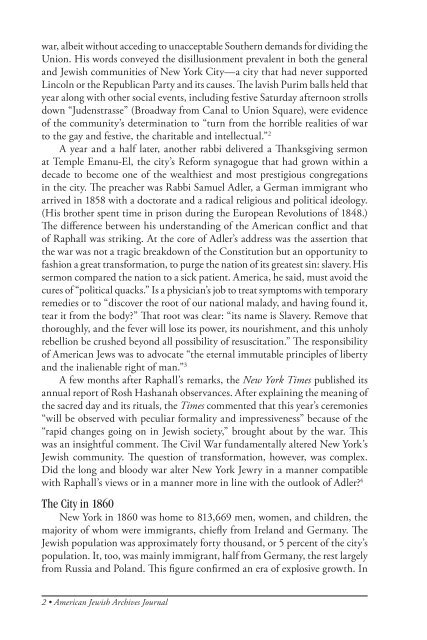American Jewish Archives Journal, Volume 64, Numbers 1 & 2
American Jewish Archives Journal, Volume 64, Numbers 1 & 2
American Jewish Archives Journal, Volume 64, Numbers 1 & 2
Create successful ePaper yourself
Turn your PDF publications into a flip-book with our unique Google optimized e-Paper software.
war, albeit without acceding to unacceptable Southern demands for dividing the<br />
Union. His words conveyed the disillusionment prevalent in both the general<br />
and <strong>Jewish</strong> communities of New York City—a city that had never supported<br />
Lincoln or the Republican Party and its causes. The lavish Purim balls held that<br />
year along with other social events, including festive Saturday afternoon strolls<br />
down “Judenstrasse” (Broadway from Canal to Union Square), were evidence<br />
of the community’s determination to “turn from the horrible realities of war<br />
to the gay and festive, the charitable and intellectual.” 2<br />
A year and a half later, another rabbi delivered a Thanksgiving sermon<br />
at Temple Emanu-El, the city’s Reform synagogue that had grown within a<br />
decade to become one of the wealthiest and most prestigious congregations<br />
in the city. The preacher was Rabbi Samuel Adler, a German immigrant who<br />
arrived in 1858 with a doctorate and a radical religious and political ideology.<br />
(His brother spent time in prison during the European Revolutions of 1848.)<br />
The difference between his understanding of the <strong>American</strong> conflict and that<br />
of Raphall was striking. At the core of Adler’s address was the assertion that<br />
the war was not a tragic breakdown of the Constitution but an opportunity to<br />
fashion a great transformation, to purge the nation of its greatest sin: slavery. His<br />
sermon compared the nation to a sick patient. America, he said, must avoid the<br />
cures of “political quacks.” Is a physician’s job to treat symptoms with temporary<br />
remedies or to “discover the root of our national malady, and having found it,<br />
tear it from the body?” That root was clear: “its name is Slavery. Remove that<br />
thoroughly, and the fever will lose its power, its nourishment, and this unholy<br />
rebellion be crushed beyond all possibility of resuscitation.” The responsibility<br />
of <strong>American</strong> Jews was to advocate “the eternal immutable principles of liberty<br />
and the inalienable right of man.” 3<br />
A few months after Raphall’s remarks, the New York Times published its<br />
annual report of Rosh Hashanah observances. After explaining the meaning of<br />
the sacred day and its rituals, the Times commented that this year’s ceremonies<br />
“will be observed with peculiar formality and impressiveness” because of the<br />
“rapid changes going on in <strong>Jewish</strong> society,” brought about by the war. This<br />
was an insightful comment. The Civil War fundamentally altered New York’s<br />
<strong>Jewish</strong> community. The question of transformation, however, was complex.<br />
Did the long and bloody war alter New York Jewry in a manner compatible<br />
with Raphall’s views or in a manner more in line with the outlook of Adler? 4<br />
The City in 1860<br />
New York in 1860 was home to 813,669 men, women, and children, the<br />
majority of whom were immigrants, chiefly from Ireland and Germany. The<br />
<strong>Jewish</strong> population was approximately forty thousand, or 5 percent of the city’s<br />
population. It, too, was mainly immigrant, half from Germany, the rest largely<br />
from Russia and Poland. This figure confirmed an era of explosive growth. In<br />
2 • <strong>American</strong> <strong>Jewish</strong> <strong>Archives</strong> <strong>Journal</strong>
















